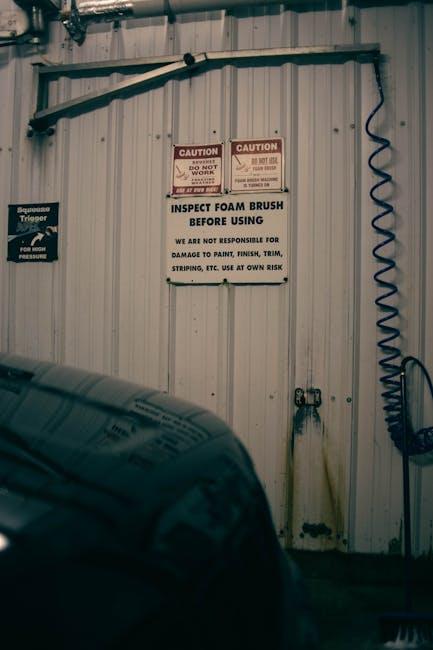There’s something undeniably satisfying about sliding into a car that gleams under the sunlight, every surface free from dirt and grime. But behind that fresh, shiny exterior lies a common question among vehicle owners: how often should you wash your car? While the answer might seem straightforward, it’s actually a balance between maintaining your car’s appearance, protecting its paint, and fitting into your lifestyle. Whether you’re a weekend warrior or a daily commuter, understanding the ideal car-washing routine can keep your ride looking sharp without turning the chore into a time-consuming ritual. Let’s explore the factors that influence how frequently your car deserves a wash—and why the right timing matters more than you might think.
Table of Contents
- The Impact of Weather Conditions on Car Washing Frequency
- Balancing Aesthetic Appeal and Paint Protection
- Understanding the Effects of Road Conditions and Environment
- Recommended Washing Schedules for Different Vehicle Types
- Choosing the Right Cleaning Products and Techniques
- Seasonal Adjustments to Your Car Washing Routine
- Q&A
- Closing Remarks

The Impact of Weather Conditions on Car Washing Frequency
Weather plays a critical role in determining how often your car needs a wash. During rainy seasons, for instance, vehicles tend to accumulate mud, dirt, and road salt, which not only dulls the paint but also accelerates corrosion if left unattended. In contrast, hot and sunny climates often expose vehicles to dust, pollen, and bird droppings more frequently, demanding more regular cleaning to maintain that fresh, glossy appearance. Understanding these environmental factors can help vehicle owners tailor their washing routine effectively.
Consider the different climate triggers below that influence washing frequency:
- Rainy/Muddy Conditions: Wash every 1-2 weeks to remove contaminants.
- Hot and Dusty Environments: Clean every 7-10 days to avoid dust buildup.
- Winter with Road Salt: Weekly washing is advisable to prevent rust.
- Dry and Polluted Urban Areas: Frequent washing may be needed every 5-7 days.
| Weather Condition | Recommended Washing Frequency | Primary Concerns |
|---|---|---|
| Rainy Season | Once every 1-2 weeks | Mud, road salt, dirt build-up |
| Hot & Dusty | Every 7-10 days | Dust, pollen accumulation |
| Winter (Salt Use) | Weekly | Salt corrosion, grime |
| Urban Pollution | 5-7 days | Pollutants, bird droppings |

Balancing Aesthetic Appeal and Paint Protection
Maintaining your vehicle’s pristine look while safeguarding its paint requires a thoughtful approach. Frequent washing enhances the car’s shine and helps remove contaminants like bird droppings, road salt, and tree sap, all of which can erode the clear coat over time. However, over-washing or using harsh materials can strip away protective wax layers, leaving your car vulnerable to scratches and environmental damage. Striking the right balance is essential, ensuring your vehicle not only turns heads but also stays protected beneath that glossy surface.
To keep your car both beautiful and shielded, consider the following best practices:
- Use gentle, pH-balanced soaps specifically designed for automotive finishes to prevent dulling.
- Adopt a regular washing schedule—approximately every two weeks—adjusting for local weather and driving conditions.
- Always dry with a microfiber towel to minimize swirl marks and water spots.
- Apply a quality wax or sealant every few months to reinforce paint protection.
| Washing Frequency | Benefit | Risk of Neglect |
|---|---|---|
| Weekly | Optimal shine and cleanliness | Potential premature wax wear if overdone |
| Biweekly | Maintained protection and good appearance | Build-up of contaminants in harsh conditions |
| Monthly | Saves time and effort | Increased risk of paint damage and dullness |

Understanding the Effects of Road Conditions and Environment
The environment your car navigates daily plays a crucial role in how often it should be cleaned. Urban areas with heavy pollution, frequent rain, or salt used on icy roads accelerate dirt and grime buildup on your vehicle’s surface. Dust, mud, and road salts not only dull the paint but also serve as abrasive agents that can wear down protective coatings. Areas with dense tree coverage may also drop sap, pollen, or bird droppings, which are particularly corrosive if left unattended. To maintain your car’s finish and structural integrity, it’s essential to consider these external factors when determining wash frequency.
For a quick reference, here’s a handy list highlighting various road conditions and their impact on car cleanliness:
- Urban traffic: Increased exposure to pollutants and grime.
- Rural roads: More mud and dust accumulation.
- Icy or snowy environments: Salt and chemicals accelerate corrosion.
- Coastal areas: Salt air leads to quicker paint oxidation.
- Forested or park areas: Sap and organic debris require prompt cleaning.
| Environment | Suggested Wash Frequency | Key Indicators for Wash |
|---|---|---|
| Urban City | Every 1-2 weeks | Visible grime, pollution film |
| Rural Roads | Every 2 weeks | Dust and mud splatters |
| Snow/Ice Regions | Weekly | Salt residue buildup |
| Coastal Areas | Weekly to bi-weekly | Salt deposits, fading paint |

Recommended Washing Schedules for Different Vehicle Types
Every vehicle type demands a tailored washing routine to preserve its appearance and functionality. For sedans and compact cars, washing every two weeks ensures that daily grime, dust, and urban pollutants don’t accumulate and dull the paintwork. If parked outdoors, especially in polluted cities, a weekly wash might be necessary. On the other hand, SUVs and trucks, which often traverse rough terrains or carry heavy loads, benefit from a biweekly wash to remove mud, road salt, and debris that could accelerate rust or damage the undercarriage.
For convertibles or vehicles with sensitive finishes, like classic cars or luxury models, a weekly gentle wash paired with periodic waxing is ideal to protect delicate surfaces from UV rays and environmental contaminants. Meanwhile, electric vehicles, gaining popularity, require washes every 3-4 weeks since they often have smoother finishes and fewer nooks for dirt to settle, but attention should be given to battery compartments and charging ports during cleaning.
| Vehicle Type | Washing Frequency | Special Considerations |
|---|---|---|
| Sedans/Compacts | Every 2 weeks | Increase if parked outside in polluted areas |
| SUVs/Trucks | Biweekly | Focus on undercarriage and mud removal |
| Convertibles/Luxury | Weekly | Gentle wash + waxing recommended |
| Electric Vehicles | Every 3-4 weeks | Avoid water intrusion around charging ports |

Choosing the Right Cleaning Products and Techniques
Selecting the ideal cleaning products for your vehicle is crucial to maintaining its aesthetic and surface integrity. Opt for pH-balanced car shampoos that are specifically formulated to be gentle on automotive paint, avoiding household detergents which can strip away protective wax layers. A microfiber wash mitt combined with a two-bucket method (one for rinse water and one for soap) helps minimize swirl marks that damage your car’s finish. Don’t forget to use a dedicated wheel cleaner to tackle brake dust and grime stubbornly clinging to alloys without abrasive scrubbing.
Technique ultimately complements the choice of products, dictating the difference between a dazzling shine and subtle scratches. When washing, always start from the top of the car and work downward, following vertical strokes to reduce swirl effects. Drying your vehicle promptly with a plush microfiber towel prevents water spots and streaks. For the best results, protect your clean car with a high-quality wax or sealant that forms a barrier against environmental contaminants.
| Cleaning Product | Purpose | Recommended Frequency |
|---|---|---|
| pH-balanced shampoo | Gentle cleaning without stripping wax | Each wash |
| Wheel cleaner | Removes brake dust and dirt | Bi-weekly |
| Microfiber mitt | Scratch-free washing | Each wash |
| Car wax or sealant | Protects paintwork | Every 2-3 months |

Seasonal Adjustments to Your Car Washing Routine
As the seasons shift, so should your approach to keeping your vehicle spotless. During the winter months, salt and grime from snowy roads can quickly accumulate, accelerating rust and paint damage. Increasing the frequency of washes not only preserves your car’s exterior but also protects vital components like the undercarriage. In contrast, warmer seasons like spring and summer bring pollen, tree sap, and insect residue that cling persistently to your paintwork, necessitating regular cleaning to maintain a pristine finish and clear visibility.
Here’s a quick guide to help you adjust your washing schedule throughout the year:
- Winter: Wash every 1-2 weeks to combat salt and slush.
- Spring: Biweekly cleaning to remove pollen and dirt buildup.
- Summer: Weekly washes to clear off bugs and dust.
- Fall: Every 2 weeks to manage fallen leaves and sap.
| Season | Recommended Washing Frequency | Key Considerations |
|---|---|---|
| Winter | Once every 1-2 weeks | Remove road salt and prevent corrosion |
| Spring | Every 2 weeks | Clear pollen and protect paint |
| Summer | Weekly | Wash off bugs, dust, and tar |
| Fall | Every 2 weeks | Eliminate leaf debris and sap |
Q&A
Q: How often should I wash my car to keep it looking its best?
A: For most drivers, washing your car every two weeks strikes a great balance between maintaining appearance and practicality. However, this can vary depending on your environment and driving habits.
Q: Does the weather affect how often I should wash my car?
A: Absolutely! In rainy or snowy climates, frequent washing helps remove salt, mud, and grime that can harm your paint. In dry, dusty areas, you might find your car looks dirty sooner, prompting more frequent washes.
Q: What are the risks of washing my car too infrequently?
A: Letting dirt, bird droppings, or tree sap sit on your paint can cause stains, corrosion, or paint damage over time. Regular cleaning helps protect the finish and extends your car’s lifespan.
Q: Can I wash my car too often?
A: While washing your car frequently isn’t usually harmful, overzealous scrubbing or using harsh detergents can wear down your paint or protective coatings. Gentle cleaning products and soft cloths keep your car safe and shiny.
Q: Should I consider professional car washing services?
A: Professional washes can offer a thorough clean and sometimes protective treatments like waxing. If you’re short on time or want to pamper your car, scheduling a professional wash monthly or seasonally is a smart choice.
Q: How do storage and parking conditions influence washing frequency?
A: Cars parked outdoors or under trees may collect dirt and debris faster, necessitating more frequent washes. Garaged vehicles are typically sheltered from many pollutants, so they can get away with less frequent cleaning.
Q: Is there a seasonal approach to washing my car?
A: Many enthusiasts recommend washing more often during winter to combat salt and deicing chemicals, and in spring to remove pollen and grime accumulated during the cold months. Summer and fall washing depends on dust and environmental exposure.
Q: How does washing my car affect its value?
A: Regular cleaning helps preserve your car’s exterior, preventing paint damage and rust, which in turn maintains resale value. A well-maintained car with a clean finish always makes a better impression on potential buyers.
Q: What’s a simple rule of thumb for car washing frequency?
A: Look at your car—if it looks dirty, feels gritty to the touch, or shows spots of bird droppings and road chemicals, it’s time for a wash. Listening to your car’s surface can be just as helpful as any schedule.
Q: Can I reduce washing frequency with protective products?
A: Yes! Applying wax, sealants, or ceramic coatings creates a barrier against dirt and contaminants, meaning you can wash less often while keeping your car looking polished. Just remember to keep up with the maintenance of those protective layers.
Closing Remarks
In the end, the ideal car wash routine is less about strict schedules and more about tuning in to your vehicle’s needs and your environment. Whether you’re battling city grime, coastal salt, or just the occasional pollen storm, paying attention to these factors will help you strike the perfect balance between keeping your ride gleaming and avoiding unnecessary work. So next time you hesitate, remember: a clean car is not just about looks—it’s a small act of care that can extend your vehicle’s life and brighten your daily drive. Wash when it counts, and let your car shine on its own terms.

